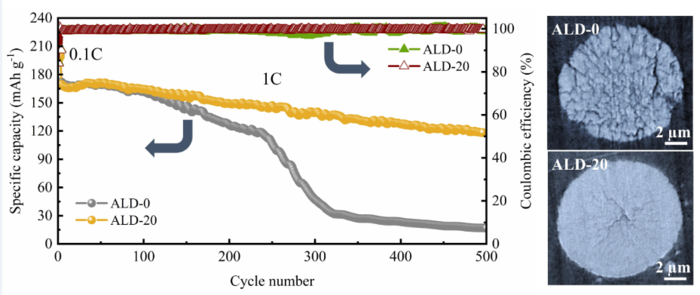Reviewed by Alex SmithApr 12 2022
The constant loss of practical capacity and a decrease in the average working voltage has hampered the commercialization of nickel-rich LiNi0.8Mn0.1Co0.1O2 (NMC811).
 NMC811 cathodes were conformally coated with a nanoscale Li2S layer via atomic layer deposition (ALD). This sulfide coating was confirmed being particularly effective to protect NMC811 from structural degradation and thereby boost its electrochemical performance. Image Credit: Journal of Energy Chemistry.
NMC811 cathodes were conformally coated with a nanoscale Li2S layer via atomic layer deposition (ALD). This sulfide coating was confirmed being particularly effective to protect NMC811 from structural degradation and thereby boost its electrochemical performance. Image Credit: Journal of Energy Chemistry.
Li/Ni cation mixing, oxygen evolution, microcracking, the irreversible layer-spinel-rocksalt phase transition and transition metal (TM) ion dissolution all contribute to performance degradation. Elemental doping, surface modification and electrolyte additives are just a few of the strategies being looked into to address these issues.
Surface modification has been demonstrated to be a simple and effective strategy among these. Coating powders onto nickel manganese cobalt (NMC) cathodes with wet chemistry is common, but controlling the coating quality and completely removing undesired residuals is difficult.
A vapor-phase alternative to wet chemical methods, atomic layer deposition (ALD), has emerged over the last decade. Compared to electrode powders or prefabricated electrodes, ALD allows for high-quality conformal and uniform films. ALD also has a low process temperature (≤ 200 °C), which allows it to precisely control film growth to a desired crystallinity and thickness at the atomic level.
Numerous coatings, such as aluminum oxide (Al2O3), tungsten oxide (WO3), titanium oxide (TiO2), cobalt (II, III) oxide (Co3O4), zirconium oxide (ZrO2), lithium metal oxides (LMO), fluorides, and phosphates have been reported to modify NMCs via wet chemistry and ALD.
These coatings are designed to address some of the issues raised earlier and, as a result, improve the performance of NMC cathodes. During charging, however, oxygen evolution continues. To develop and commercialize Ni-rich NMC and other layered oxide cathode materials, oxygen evolution must be suppressed.
Professor Xiangbo Meng of the University of Arkansas, Argonne National Laboratory scientist Yuzi Liu, Brookhaven National Laboratory scientist Xianghui Xiao, and colleagues published their observations in the Journal of Energy Chemistry.
The researchers in their study reported a sulfide coating, amorphous Li2S via ALD. The conformal nano-Li2S coating guarded the NMC811 cathode, improving rate performance, capacity retention and mitigating voltage reduction. As conventional non-sulfide coatings do not display this behavior, the nano-Li2S coating also eliminated the O2 released from the NMC cathode during the charging process.
The ALD coatings should also improve the mechanical integrity of the NMC811 electrode and NMC powders themselves, (ii) stabilize the interface between the NMC electrode and the electrolyte, (iii) alleviate the structural phase transition of NMC materials and (iv) eliminate O2 released from NMC lattices, according to the analyses.
All of these advantages of ALD Li2S coatings are important for addressing NMC811 electrode technical issues and enhancing the design of high-performance lithium-ion batteries (LIBs).
As a result of this research, sulfides appear to be an important class of coating materials for addressing the performance issues that NMCs and other layered cathodes face in lithium-ion batteries. Other researchers may be inspired by these findings to investigate a variety of sulfides as novel coating films for high-performance NMCs and other cathodes in the future.
Journal Reference:
Wang, X., et al. (2022) High-performance LiNi0.8Mn0.1Co0.1O2 cathode by nanoscale lithium sulfide coating via atomic layer deposition. Journal of Energy Chemistry. doi.org/10.1016/j.jechem.2022.02.015.